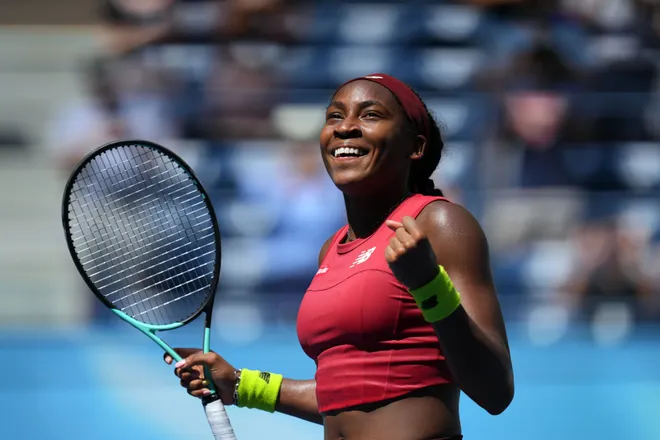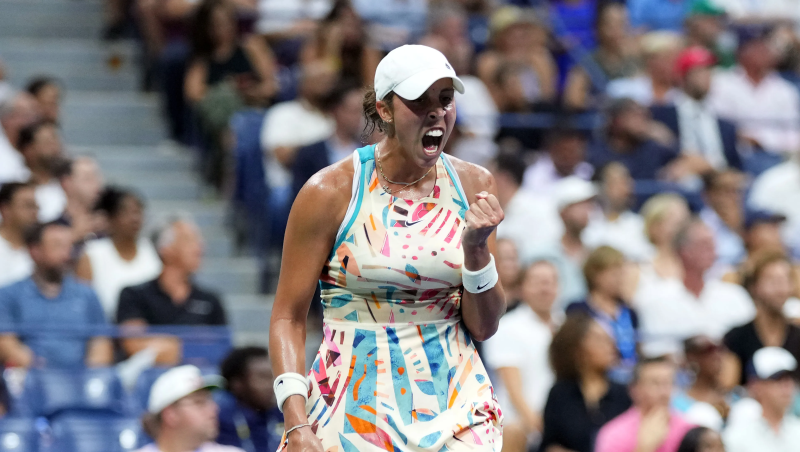Tennis finally allowing player-coach interactions during matches win for players and fans
NEW YORK — On the verge of losing the second set Sunday to Caroline Wozniacki, Coco Gauff walked toward the corner of Arthur Ashe Stadium where her coach Brad Gilbert was sitting and ready to give instructions for the next game.
“Positive attitude here,” he could be heard saying on one of the the microphones placed around the court. "You've got to make her move. Don’t let her control the center of the court.”
Gauff, in a sour mood because she just dropped her serve, wasn’t having it.
“Please, just stop,” she responded, producing a moment that went viral on social media.
A few hours later, Gauff more or less laughed it off, saying she needed a mental reset more than tactical advice in that moment.
“I can't really hear him on Ashe,” Gauff said. “Sometimes maybe you guys are hearing more than what I'm hearing.”
At the US Open this year, that is probably a good bet.

Microphones positioned near the boxes where players keep their towels have allowed fans to hear an inordinate amount of chatter between players and their teams, which has been allowed on both the ATP and WTA Tour this year in a reversal of the long-standing rule against on-court coaching.
While much of it has been completely banal, viewers have been treated to several moments where tactics and coach-player dynamics have been laid bare for the entire world to see.
“You have to watch your words, right?” said Wim Fissette, the coach of women’s quarterfinalist Qinwen Zheng, who admitted the microphones made him self-conscious. “Of course just like the players go through some emotions during the match, so do we as team members. So I'm trying to be aware of the microphones and, like, watch my words. But for the fans it's interesting, absolutely.”
Sports fans have long had some access to the way coaches interact with players during the heat of battle, whether it's a camera in the locker room during a pregame speech or an “inside the huddle” moment during timeouts that is now standard issue on NBA broadcasts.
But whereas those scenes often feel a little too varnished and not particularly insightful, the back-and-forth in tennis is a little more organic and novel. Maybe that's because it’s so new.
For decades, tennis was a sport where players were supposed to figure things out on their own during the heat of competition. Though coaching was forbidden in the rules, players and coaches long contended that it took place in one form or another, often through discreet hand signals or sometimes by communicating in a language that the chair umpire didn't understand.
The most famous controversy surrounding on-court coaching occurred during the 2018 US Open women’s final when chair umpire Carlos Ramos issued a warning to Serena Williams because he spotted her coach, Patrick Mouratoglou, making a gesture that was interpreted as a direction to attack the net.
Williams was so put off by the accusation that she berated Ramos multiple times, eventually leading to a game penalty for verbal abuse in the second set against Naomi Osaka.
That wouldn't happen anymore because the ATP, WTA and the Grand Slams have aligned — hand signals are fine and short conversations are allowed between points when a player is on the same side of the court as their coaching box.
These are usually quick exchanges with few words, but they have been prominent in some big matches at the US Open because they offer a unique window into the player-coach dynamics and how the matches are evolving tactically.
“We try to keep it simple as possible,” said Anton Dubrov, who coaches new women’s No. 1 and US Open semifinalist Aryna Sabalenka. "She has already a lot of emotions and thoughts on the court. You cannot talk too much with her, because again, it's so loud and you have just few seconds you can tell just one, two words. We are more talking with each other, communicate, like, what we can tell her. But mostly just one, two simple words just to maybe shift her focus back on herself.”
Other players seem to want more specific feedback. The microphones have picked up extensive dialogue during matches between Ben Shelton and his father Bryan, who coached him to an NCAA championship at Florida and left that job earlier this year to be a full-time presence on tour.
During Tuesday night’s quarterfinal victory, for instance, the 20-year-old Shelton waited in his chair between the third and fourth sets while Frances Tiafoe went off court for a clothing change. When he came back and it was then allowable for Shelton to get coaching, Bryan leaned over the railing and told him he should not hit his sliding serve as much and instead go with heavier kick.
“That one is working tonight,” Bryan Shelton said. “That one is the go-to. You can you go to his forehand or his backhand with that one. That one's good. Let’s go. Good start here.”
The elder Shelton, who played for nearly a decade on the ATP Tour, explained Wednesday that their communication was a helpful part of navigating these new experiences as a pro.
“Sometimes it's more about just trying to get him positive and get him in the right frame of mind to help him stay in the moment, stay relaxed, or to fire up so he can go out there and play confidently and play his best tennis,” Shelton said. "Sometimes there's a tactical suggestion or a technical thought, but it's things that I know that he can digest really, really well. So I think that understanding and that trust that he has in me as a coach helps in that situation to, usually when I say something, he nods, and he gives affirmation that, ‘I got it, let's go.’”
But as the Gauff example showed, players aren't always in the mood to hear from their box — even if mid-match coaching has generally been helpful to what they’re trying to accomplish.
“They understand what it is,” Gauff said. “Before I went on the court or before we started this tournament, I’ll tell them, ‘Yeah, I might say some things like ‘Stop talking.’ I did it in Cincinnati. They don't take any offense to it. They know sometimes I just need to not hear anything.
“But sometimes I'll ask them, 'What am I doing wrong?' I don't know if the camera picks that up. Probably not. But I sometimes will say, 'What am I doing wrong?' And that's when I want advice.”

Disclaimer: The copyright of this article belongs to the original author. Reposting this article is solely for the purpose of information dissemination and does not constitute any investment advice. If there is any infringement, please contact us immediately. We will make corrections or deletions as necessary. Thank you.







